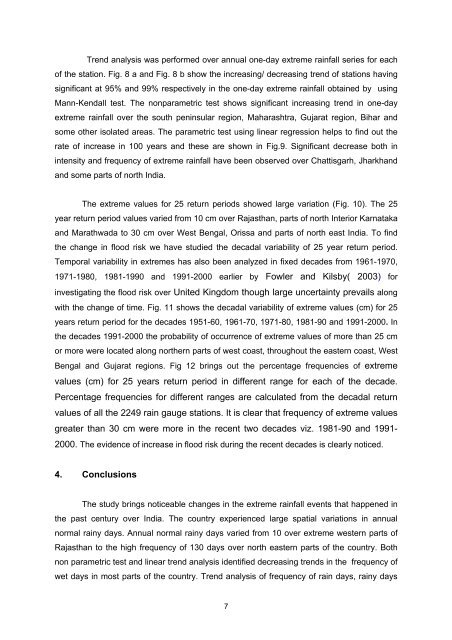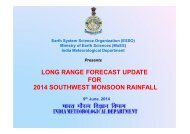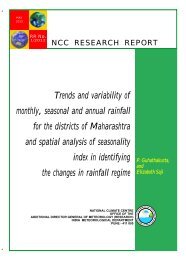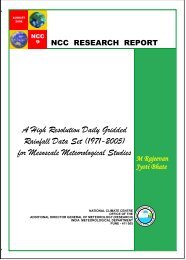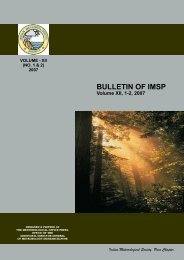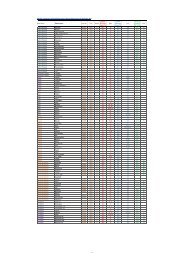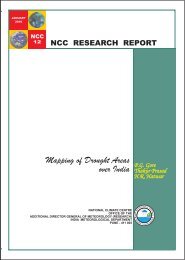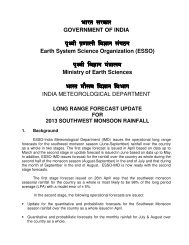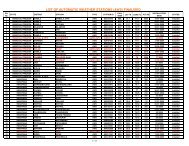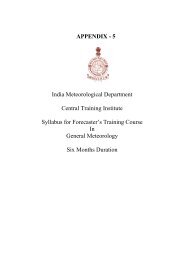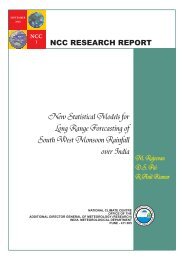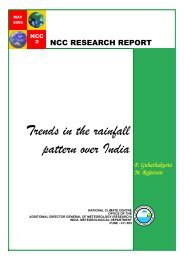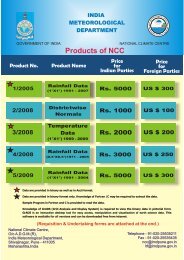Changes in extreme rainfall events and flood risk in ... - (IMD), Pune
Changes in extreme rainfall events and flood risk in ... - (IMD), Pune
Changes in extreme rainfall events and flood risk in ... - (IMD), Pune
Create successful ePaper yourself
Turn your PDF publications into a flip-book with our unique Google optimized e-Paper software.
Trend analysis was performed over annual one-day <strong>extreme</strong> ra<strong>in</strong>fall series for eachof the station. Fig. 8 a <strong>and</strong> Fig. 8 b show the <strong>in</strong>creas<strong>in</strong>g/ decreas<strong>in</strong>g trend of stations hav<strong>in</strong>gsignificant at 95% <strong>and</strong> 99% respectively <strong>in</strong> the one-day <strong>extreme</strong> ra<strong>in</strong>fall obta<strong>in</strong>ed by us<strong>in</strong>gMann-Kendall test. The nonparametric test shows significant <strong>in</strong>creas<strong>in</strong>g trend <strong>in</strong> one-day<strong>extreme</strong> ra<strong>in</strong>fall over the south pen<strong>in</strong>sular region, Maharashtra, Gujarat region, Bihar <strong>and</strong>some other isolated areas. The parametric test us<strong>in</strong>g l<strong>in</strong>ear regression helps to f<strong>in</strong>d out therate of <strong>in</strong>crease <strong>in</strong> 100 years <strong>and</strong> these are shown <strong>in</strong> Fig.9. Significant decrease both <strong>in</strong><strong>in</strong>tensity <strong>and</strong> frequency of <strong>extreme</strong> ra<strong>in</strong>fall have been observed over Chattisgarh, Jharkh<strong>and</strong><strong>and</strong> some parts of north India.The <strong>extreme</strong> values for 25 return periods showed large variation (Fig. 10). The 25year return period values varied from 10 cm over Rajasthan, parts of north Interior Karnataka<strong>and</strong> Marathwada to 30 cm over West Bengal, Orissa <strong>and</strong> parts of north east India. To f<strong>in</strong>dthe change <strong>in</strong> <strong>flood</strong> <strong>risk</strong> we have studied the decadal variability of 25 year return period.Temporal variability <strong>in</strong> <strong>extreme</strong>s has also been analyzed <strong>in</strong> fixed decades from 1961-1970,1971-1980, 1981-1990 <strong>and</strong> 1991-2000 earlier by Fowler <strong>and</strong> Kilsby( 2003) for<strong>in</strong>vestigat<strong>in</strong>g the <strong>flood</strong> <strong>risk</strong> over United K<strong>in</strong>gdom though large uncerta<strong>in</strong>ty prevails alongwith the change of time. Fig. 11 shows the decadal variability of <strong>extreme</strong> values (cm) for 25years return period for the decades 1951-60, 1961-70, 1971-80, 1981-90 <strong>and</strong> 1991-2000. Inthe decades 1991-2000 the probability of occurrence of <strong>extreme</strong> values of more than 25 cmor more were located along northern parts of west coast, throughout the eastern coast, WestBengal <strong>and</strong> Gujarat regions. Fig 12 br<strong>in</strong>gs out the percentage frequencies of <strong>extreme</strong>values (cm) for 25 years return period <strong>in</strong> different range for each of the decade.Percentage frequencies for different ranges are calculated from the decadal returnvalues of all the 2249 ra<strong>in</strong> gauge stations. It is clear that frequency of <strong>extreme</strong> valuesgreater than 30 cm were more <strong>in</strong> the recent two decades viz. 1981-90 <strong>and</strong> 1991-2000. The evidence of <strong>in</strong>crease <strong>in</strong> <strong>flood</strong> <strong>risk</strong> dur<strong>in</strong>g the recent decades is clearly noticed.4. ConclusionsThe study br<strong>in</strong>gs noticeable changes <strong>in</strong> the <strong>extreme</strong> ra<strong>in</strong>fall <strong>events</strong> that happened <strong>in</strong>the past century over India. The country experienced large spatial variations <strong>in</strong> annualnormal ra<strong>in</strong>y days. Annual normal ra<strong>in</strong>y days varied from 10 over <strong>extreme</strong> western parts ofRajasthan to the high frequency of 130 days over north eastern parts of the country. Bothnon parametric test <strong>and</strong> l<strong>in</strong>ear trend analysis identified decreas<strong>in</strong>g trends <strong>in</strong> the frequency ofwet days <strong>in</strong> most parts of the country. Trend analysis of frequency of ra<strong>in</strong> days, ra<strong>in</strong>y days7


